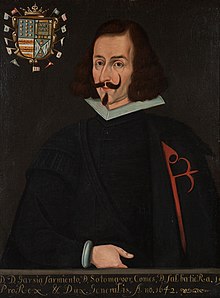García Sarmiento de Sotomayor
|
Don García Sarmiento de Sotomayor Conde de Salvatierra Marqués de Sobroso Caballero de Alcántara |
|
|---|---|
 |
|
| Viceroy of New Spain | |
|
In office November 23, 1642 – May 13, 1648 |
|
| Monarch | Philip IV |
| Prime Minister | Count-Duke of Olivares |
| Preceded by | Juan de Palafox |
| Succeeded by | Marcos de Torres |
| 16th Viceroy of Peru | |
|
In office September 20, 1648 – February 1655 |
|
| Monarch | Philip IV |
| Preceded by | The Marquis of Mancera |
| Succeeded by | Luis Enríquez de Guzmán |
| Personal details | |
| Born | c. 1595 Spain |
| Died | June 26, 1659 Lima, Peru |
| Religion | Catholic |
| Signature |  |
Don Diego García Sarmiento de Sotomayor, Marquis of Sobroso and 2nd Count of Salvatierra (Spanish: Don García Sarmiento de Sotomayor, Marqués de Sobroso y segundo Conde de Salvatierra) (c. 1595, Spain – June 26, 1659, Lima) was a Spanish viceroy of New Spain (November 23, 1642 to May 13, 1648) and of Peru (1648 to 1655).
García Sarmiento de Sotomayor was born in Spain in the last decade of the Sixteenth Century. He was a descendant of Don Diego de Sarmiento, a knight commander of the Order of Alcántara and gentleman in waiting to the king. He married the noble woman Doña Antonia de Acuña y de Guzmán, who accompanied him to New Spain as the virreina.
When New Spain Viceroy Diego López Pacheco, 7th Duke of Escalona, a first cousin of King John IV of Portugal, fell under suspicion at the Spanish Court for possible links to the Portuguese, King Philip IV of Spain gave orders to Visitor-general and Bishop of Puebla Don Juan de Palafox y Mendoza to remove the viceroy from office and became viceroy himself. However, his tenure was short lived and the crown named Sarmiento de Sotomayor on July 30, 1642 to replace him. Palafox had hoped to remain as viceroy, since he had plans to undertake a sweeping reform in New Spain, but the crown's appointment of Salvatierra ended that hope. Salvatierra landed in Veracruz in early October 1642 and arrived in Mexico City on November 23, 1642, and took up his duties as viceroy. Palafox remained a powerful figure in New Spain,retaining his posts of visitor-general and Bishop of Puebla (New Spain's second largest city). Palafox had undertaken a vigorous political reform when he was viceroy, which Salvatierra sought to overturn—and succeeded. The period between Salvatierra's 1642 arrival and Palafox's forced departure in 1649 from New Spain for a minor bishopric in Osma, Spain "inaugurated a period of severe political tension, marked by the development of a powerful alliance bent on destroying Palafox's [reform] programme in all its manifestations."
Like earlier viceroys, he was soon faced with major flooding in the city (1645). The canal of Nochistongo was obstructed, and this allowed the water of Lake Zumpango to enter into Lake Mexico, raising its level and flooding parts of the city. The viceroy ordered the canal cleaned and the obstructions removed. This removed the danger to the city.
...
Wikipedia
